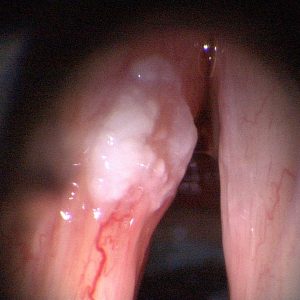Leukoplakia is a condition where thick white or red patches form on the surface of the vocal cords. These patches are caused by irritation or damage to the top layer of the vocal cords. Common causes include smoking, acid reflux, and long-term voice overuse. These lesions may be reactive due to irritation, but sometimes they can be precancerous, which means they have the potential to turn into cancer if left untreated. Rarely is it cancerous.
Many people with leukoplakia notice that their voice sounds hoarse, rough, or weak. You might feel like you're straining to speak, or that your voice tires out more easily. Some people lose their vocal range, especially when trying to sing or speak loudly.
Your doctor will first look at your vocal cords using a small camera, often with a technique called stroboscopy to check how your vocal cords move. If the white patch looks concerning, your doctor may recommend a biopsy—this means taking a small piece of the lesion to look at under a microscope.
If the lesion is on the surface and not too deep, it can sometimes be treated right in the office using a laser (like a blue laser or KTP laser). The doctor uses a thin scope through the nose and a precise laser to remove the patch. This is done with numbing medicine, and you're awake but comfortable during the procedure. If the lesion is larger or deeper, it may need to be removed in a surgical procedure at a hospital or surgery center. This is called an outpatient procedure, which means you go home the same day—no overnight stay is needed.
Most people recover within a few days to a week. Your doctor may recommend voice rest (no talking or whispering for a short time) to help your vocal cords heal. You'll also be advised to stop smoking or treat acid reflux if those are contributing factors. Regular check-ups are important because leukoplakia can come back.
Benign keratosis is a condition where the surface of the vocal cords becomes thick and rough. It often looks like white patches, and the texture may appear bumpy or wart-like. This happens when the top layer of the vocal cords responds to long-term irritation—commonly from smoking, acid reflux, voice overuse, or environmental exposure like air pollution or chemicals. “Benign” means it’s not cancer, but the condition still needs to be monitored because it can sometimes change or worsen.
Benign keratosis usually develops slowly over many months or years, so the voice changes may sneak up on you. People often notice increasing hoarseness, raspiness, or vocal fatigue. You might feel like your voice is rough, strained, or weak, and your vocal range may become more limited—especially if you sing or speak a lot. While the condition itself forms gradually, some people experience a more sudden change in voice if the lesion thickens significantly, becomes irritated, or is associated with a cold or heavy voice use.
Your doctor will examine your vocal cords using a small camera and may use stroboscopy to check how well your vocal cords vibrate. If the lesion looks clearly benign and isn’t affecting your voice too much, your doctor may suggest watchful waiting, along with lifestyle changes like quitting smoking or treating acid reflux.
For surface-level keratosis, the doctor may use a laser (like a blue laser or KTP laser) during an in-office procedure. You’ll be awake but your throat will be numbed, and a small flexible scope is used through your nose to treat the lesion precisely. If the lesion is thicker, or if a full biopsy is needed to examine it more closely, your doctor may recommend an outpatient surgery—a short procedure under general anesthesia where you go home the same day.
Most people recover within a few days to a week. Voice rest is usually recommended, and your doctor may talk to you about avoiding irritants like smoking, acid, or heavy voice use. Regular follow-up is important. The keratosis can return or change over time.

Keratosis

 YouTube Channel
YouTube Channel
